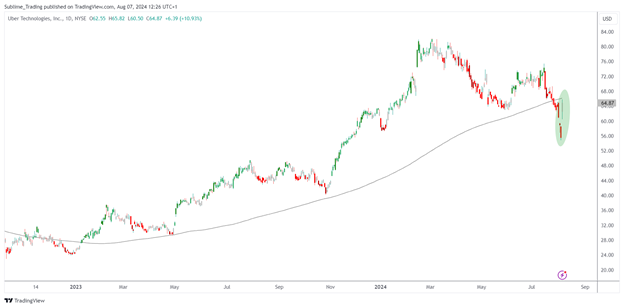- Uber reported second-quarter revenue of $10.7 billion and gross bookings of $39.95 billion, surpassing market forecasts.
- The company's earnings per share of 47 cents exceeded expectations by 16 cents, suggesting a stronger path to profitability.
- The quarter also saw Uber enhance its technological edge by increasing autonomous vehicle trips through collaborations with Waymo and Waabi.
Uber Technologies Inc UBER financial results for the second quarter have significantly surpassed market expectations, showing strong growth in several key areas.
The company reported revenue of $10.7 billion and gross bookings of $39.95 billion, both exceeding analysts' forecasts of $10.57 billion and $39.68 billion, respectively.
Earnings per share also beat predictions, coming in at 47 cents instead of the expected 31 cents, indicating a solid path to profitability for the ride-sharing giant.
This growth was driven by increased demand for ride-sharing as people returned to the office and began socializing more after the pandemic.
Uber experienced notable growth in Latin America and the Asia Pacific regions, with Brazil, Australia, and India standing out as markets with significant gains in both ride-sharing and food delivery services.
This success highlights Uber's effective market strategy and the scalability of its business model across different economies.
Additionally, Uber made strides in innovation this quarter by expanding its use of self-driving vehicles. Thanks to partnerships with Alphabet’s Waymo and the startup Waabi, the company saw a six-fold increase in autonomous trips.
This progress not only boosts the efficiency of Uber's core services but also places the company at the forefront of transportation technology.
Following strong quarterly results, Uber's stock experienced a significant upswing, with shares rising by 10%. This rebound is noteworthy, given the stock's 15% decline in August.
Previously, the stock fell from an all-time high of $82 in March to a low of $54 in August, marking a 33% drop. However, the recent recovery has reduced the annual loss to 20%.

Now trading above this year's high of $63, the stock has created new support at this level, which is expected to boost investor confidence and possibly lead to further gains.
Despite a year-to-date dip of nearly 5% from an earlier peak of 33%, the current momentum might serve as a strategic turning point for the company's market valuation in the future.
After the closing bell on Tuesday, August 6, the stock closed at $64.87, trading down by 10.93%.
This article is from an unpaid external contributor. It does not represent Benzinga's reporting and has not been edited for content or accuracy.
Edge Rankings
Price Trend
© 2025 Benzinga.com. Benzinga does not provide investment advice. All rights reserved.
Trade confidently with insights and alerts from analyst ratings, free reports and breaking news that affects the stocks you care about.